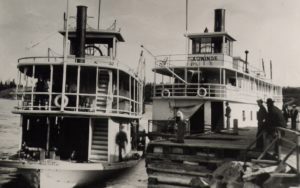Click on the “play” button to hear the diary episode read aloud, and click on the green tab 1 to learn more about a word or phrase.
Find Du Vernet on a map.
Friday, July 22:
Left by the Keenora 2 at 8 A.M. The morning was dull but the clouds added to the river scene; one spot especially where the light green crop of grain, with a little cottage nearby, was perfectly reflected in the still water, lives in my memory. At about two o’clock we reached the upper end of the Indian Reserve of Hungry Hall 3 . There we saw Joseph McLeod 4 , the Christian 5 Indian 6 , on the wharf, and he smiled, and saluted me with his hand.
After crossing the big Traverse 7 we entered the Islands of the Lake of the Woods 8 . This lake well deserves its name. The islands are covered with evergreen trees 9 chiefly of young growth, as the larger trees have been cut or burnt. There are some pine trees with their tall tops, bent by wintry blasts. Poplar abounds and the white stems of these trees add to the effect that it can truly be said of the islands they are “with verdure clad.” 10

There are 18,000 of them, of all sizes, most of them fairly round in shape. In contrast with the thousand islands of the St. Lawrence 11 , what struck me most was the breadth and softness of the scene here. In every direction vistas would open up stretching away for 5 or 10 miles. As the steamer 12 sailed on, the effect could be compared with nothing else than that of a Kaleidoscope: islands would change their relative positions and a new combination would take place. Here and there rocky cliffs could be seen, their crest barely covered with water.
About 14 miles from Rat Portage 13 , the scenery became grander, when the steamer passed between islands closer together, with high bluffs. One was called Crow Rock, where a cross seemed to be formed and the Channel turned at a right angle, it was very fine.
As we approached the gap, the view from the captain’s bridge, where I had been invited, could scarcely be surpassed for exquisite beauty: it was nearly 8 o’clock and the setting sun was gilding the clouds. The shadows from the well-wooded shores began to deepen across the path of the steamer and the water was a perfect mirror. As we entered the gap it seemed as though we were passing through a succession of little miniature lakes, each one closing in upon us, the light of the setting sun forming the central throne. As we passed this scene, vestibule after vestibule, we went through the Devil’s Gap 14 . On the east side there is a large rock like a skull on which someone has painted red eyes, lips, and a black mustache and goatee: very grotesque. But Rat Portage looked very beautiful in the evening light, and we arrived about 8:20 p.m.

